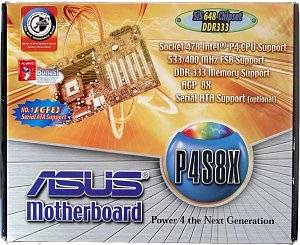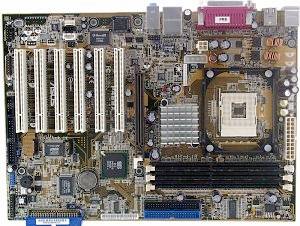ASUS P4S8X
(SiS648) Mainboard
|

The board belongs to the Gold series which stands for a blazing set of components
and loads of integrated capabilities. We has a preproduction sample in our lab.
Accessories: - Package of a standard design;
- Documentation:
user manual in English, brief installation manual in 11 languages;
-
Cables: 2 Serial ATA, 2 ATA66/100/133, 1 ATA33 and FDD;
- Bracket with
a COM port;
- Bracket with 2 USB and Game ports;
- Bracket
for the rear computer panel;
- 2 CDs containing:
-
drivers;
- DirectX 8.1;
- Adobe Acrobat Reader;
-
3Deep;
- PC-Cillin 2002;
- ASUS Live Update;
-
ASUS HotKey;
- ASUS Logo;
- ASUS PCProbe;
-
ASUS Screensaver;
- Winbond Voice Editor;
- InterVideo
WinDVD;
- InterVideo WinRip;
- InterVideo WinCoder;
-
InterVideo WinProducer.

The layout really suffers from such a heap of integrated controllers and their
connectors: audio-ins are in front of the PCI, and the IDE RAID are behind them,
when a video card is installed it's difficult to handle the memory modules, and
a lot of connectors are pressed to the left edge. It can be difficult as well
to reach some jumpers when the board is already installed. Their functions are
shown on the textolite. The 2-channel switching voltage regulator incorporates
5 capacitors of 1500 uF and several less capacious ones. The following
controllers are integrated: - audio controller based on the chipset's
capabilities and C-Media CMI9739A AC'97 codec supporting 5.1 audio systems and
having connectors for front audio inputs/outputs and for SPDIF;
-
network controller based on the chipset's capabilities and supporting 10BaseT/100BaseTX
-
IDE RAID controller based on the Promise PDC20376 chip supporting RAID 0 and 1
on the ATA133 and SerialATA protocols;
- IEEE 1394 bus controller
based on the chipset's capabilities.
Thanks to the Winbond W83697SF
Smart I/O controller the board supports (and have connectors) readers for smart
cards. The board incorporates ASUS Multi-Language BIOS, ASUS POST Reporter
(reports about problems during booting), ASUS MyLogo2 (for displaying your images
when the system boots), ASUS EZ Plug (allows using a power unit which doesn't
comply with the ATX 2.03 standard), ASUS Q-Fan (auto fan speed control) and ASUS
EZ Flash. +5 V supplied in the StandBy mode is indicated with the green
LED, and when a 3.3V card is inserted into the AGP slot you will see the red LED
going on which means that the card is incompatible (it's impossible to turn on
the computer even with the Power button). The system monitoring
is supported by the ASUS ASB100 Bach chip. What is controlled: -
processor voltage, +3.3, +5 and +12 V;
- speed of 3 fans;
-
temperatures of the processor (a built-in sensor), the board (a built-in sensor)
and an external sensor connected to the board.
There are 3 connectors
for adjustable connection of fans. Brief characteristics of the board:
memory slots - 3 DDR SDRAM; expansion slots - AGP/ 6 PCI; I/O ports - 2 COM/ LPT/
2 PS/2/ 6 USB 2.0 / 2 IEEE1394 (the controller supports up to 3 ports); dimensions
- 305x245 mm.

Adjustment
can be carried out with:
| jumpers and switches | Jumper
to clear up the CMOS | | | Jumper for starting
up computer from USB devices | | | Jumper for
starting up computer from a PS/2 keyboard | | | BIOS
based on the 6.00 version from Award | Setup of memory timings | + | CAS
Latency, RAS Precharge Time, RAS To CAS Delay, RAS Active Time, Timing Constraint
Control, MA Delay 1T/2T Select | | Setup of memory frequency | + | Auto,
100, 133, 166 and 200 MHz | | Setup of AGP bus | + | |
| Setup of PCI bus | + | | | Changeable
scaler of AGP and PCI buses | + | Chipset Clock Mode:
Synchronous, Asynchronous | | Manual assignment of interrupts | + | |
| Changeable FSB frequency | + | 100-166 MHz in
1MHz steps | | Changeable CPU multiplier | + | x8-x24 |
| Changeable core voltage | + | 1.5-1.8 V in 0.025V
steps | | Changeable memory voltage | + | 2.5,
2.6 and 2.7 V | | Changeable chipset voltage | - | |
| Changeable AGP bus voltage | + | 1.5, 1.6 and
1.7 V | We used the latest available version of the BIOS -
1004 beta 002. This is a slick board providing you with wide possibilities
to attach various devices, nice configuring features and plenty of leeway for
overclocking the system at a smaller sum of money than the Intel based solutions
are offered at. The only thing I don't fancy is a relatively weak CPU's voltage
stabilizer.
Test results:
Write a comment below. No registration needed!
|
|



